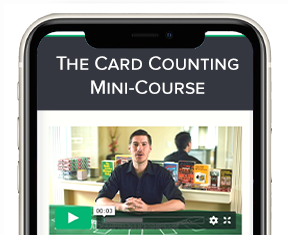If you are using a balance count like Hi-Lo, the count we use and teach, then you will have to convert your “Running Count” to the “True Count.” The True Count gives you a “count per deck,” so you know how to bet and when to use playing deviations.
To convert to the True Count, you take your Running Count and divide it by the number of decks remaining.
But how accurate does your Deck Estimation need to be? When you look at the discard tray, is it best to estimate to the nearest full deck, half-deck, or quarter deck?
Before I share my opinion, I’ll just share a bunch of numbers for you. I ran computer simulations of various scenarios to see the impact of using a full deck, half-deck, quarter-deck divisor, or even full-deck for the first half of the shoe and 1/2 deck for the last half of the shoe (I’m calling this full deck, half deck).
Scenario: 6 Deck Game (4.5 of 6 decks dealt): S17, DAS, RSA*
Bet Spread: 1-12 Spread, wong-out at True -2
EV with Full-Deck Divisor: $39.80/hr; N0: 343 hours
EV with Half-Deck Divisor: $42.14/hr; N0: 331 hours (6% more than Full Deck)
EV with Quarter-Deck Divisor: $42.50/hr; N0: 329 (7% more than Full Deck)
EV with Full-Deck, Half Deck Divisor: $41.96/hr; N0: 328 (5% more than Full Deck)
So as you can see, a more accurate divisor is more valuable. However, it’s not as much as you might think. Even the difference between using a full deck divisor or a quarter-deck divisor is less than 10% in this scenario.
Side Note: I ran several other sims, and discovered that deck estimation creates a bit more of an impact on your EV if you are playing through all negative counts. However, playing through negative counts costs you MUCH more than you can gain from a more accurate divisor. So the numbers are a bit deceiving.
So What Divisor Should You Use?
There are both practical considerations and philosophical considerations. I’ll briefly share my opinion on each.
Practical Considerations
More complex isn’t always better.
First off, more complex can mean more room for error. Most of us can, with a little practice, divide our running count by any whole number. But dividing by half-decks is a bit more of mental gymnastics. And dividing by quarter-decks takes even more brain power.
The more mental energy it takes to do your true count conversion, the more room there is for making mistakes. And mistakes will cost you MUCH more than the 5-10% increase in EV you might get for using a more complicated divisor.
Secondly, the more complex you make it, the longer it takes to come to your decision. Time is money at card counting, so you want to use a divisor that you can do perfectly (every time) AND quickly.
Complex, but not natural just looks odd.
I’ve said many times that card counting doesn’t always look “normal.” Normal is gambling, playing poorly, and losing money. So we don’t want to look too normal. But if you’re staring at the discard tray between every hand, you’re just going to bring unwanted attention onto yourself.
The BJA Philosophy
There’s a philosophical decision card counters need to make. You could decide that your goal is to choose theoretical edge over anything else. If that’s the case, you should probably learn the most complex card counting system, memorize every deviation possible, and use the most accurate deck estimation possible (I’ve heard of card counters that kept a side-count of the number of cards dealt so they always have the most accurate divisor possible).
But that’s not the philosophy I’ve used when I played, when I’ve managed teams, or when training people through Blackjack Apprenticeship.
Our philosophy is “biggest bang for your buck” decisions, then getting out there and getting the casinos’ money! I believe Hi-Lo is the biggest bang for your buck. And learning the top 20-ish deviations is going to give you 95% of the EV of learning ALL the deviations, with a fraction of the effort.
So in deciding what deck estimator to use, my philosophy for shoe games is this:
- Get REALLY accurate (and quick) at using a full-deck divisor.
- Then, learn to do Full deck, half deck.
- If you get REALLY bored with that, then learn to use a half-deck divisor for the entire shoe.
My Philosophy for double deck and single deck:
- Use a half-deck divisor. If you’ve already learned full deck, half deck then you can already divide by 1.5 decks and 0.5 decks.*
- If you get REALLY bored with that, then learn to divide by quarter decks.
How to Practice

One of the drills we provide with a BJA Membership is the “True Count Drill.” You can choose any number of decks from 1 to 8, then set it to either full-deck or half-deck divisor and have it give you random running counts and decks remaining. This way, you can practice a lot of true count decisions quickly. It also shows you a discount tray so you can visualize what you will be seeing in the casino.
If you don’t want a BJA Membership (what, are you crazy?!?), you can simulate this at home. It will just be a bit more tedious and time consuming.
Conclusion:
Regardless of what you decide and how you decide to train, get accurate, then get fast. Then get the casinos’ money!
Until next time, keep generating EV!
-Colin
*I’m assuming 100 rounds/hr played or observed.
** Dividing by 0.5 decks is as simple as multiplying your running count by 2.

